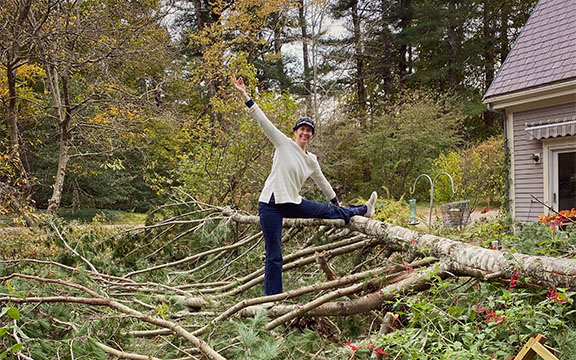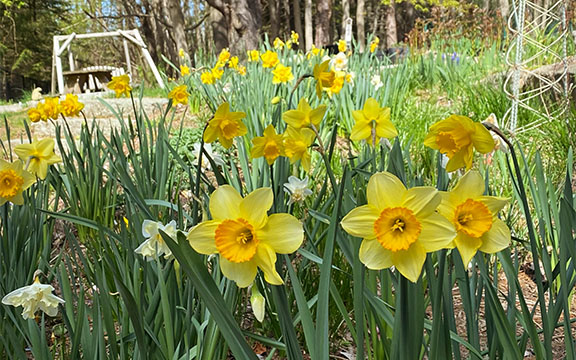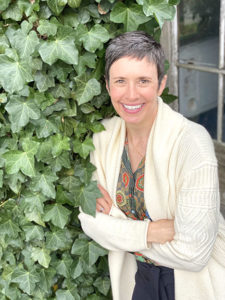
Photo: The tree with Gita in tree pose!
The howl of a nor’easter blew against my house and rattled the windows. A rifle-like crack, roaring whoosh, and an earth-shaking thud shocked me fully awake. I assumed another tree had fallen. Finally, night gave way to grey dawn and I huddled around my coffee mug in the kitchen.
I looked out of the window as rain lashed the deck. The tangled corpse of a fallen Eastern White Pine lay across the garden. Ten feet to the west and it would have crushed the house. The coral heads of dahlias peeked out from under the fallen limbs. Nature kept dancing—the dying tree, the defiant dahlias, the swirling winds—a cycle of creation, destruction, and resurrection that I was helpless to control.
It was almost Halloween in New England. The storm left boats washed up on shore, a half a million without power, and kids reveling in days without school. The gulf stream in Mexico had ridden up the coast. But as the warm air traveled north it had smacked into the frozen hand of the Canadian jet stream. The clash between the two extremes was so unstable that the gulf stream was sucked farther northwards, only to be whipped back down where it unleashed the energy of high winds and torrential rains on our coast. The storm was a collision of forces that spanned thousands of miles of land, ocean, and atmosphere.
I love to geek-out and study storms; scientific understanding is interesting but it also boggles my mind how humans used to deal with these storms with little to no warning. The parsing of weather cycles into science lingo is like a daily moveable map that leads us into deeper intellectual—and action-oriented—understanding. But when faced with the apparent cruelty of Mother Nature the scientific map bends around our feet, having only delivered us to a closed door. Our intellect is only as strong as our willingness to admit its limitation.
At that moment—with all precautions completed yet with winds still howling and the house shaking in the dark night—we are left with no choice but to drop the map, open our inner door, and go within. Perhaps at these moments we seek something like faith.
By Thanksgiving I finally had help over to chainsaw the tree and cart it into the woods. It had crushed a cold frame, knocked pathway pavers on end, and left deep holes where branches lanced the earth. During winter snow and ice covered the damage; but finally, spring arrived.

Photo: A river of daffodils in Gita’s garden.
One April morning I stood at the back door and sipped coffee. On the slope where the tree had fallen a river of daffodils now waved in the breeze. Fuzzy grey leaves on the lavender uncoiled like tiny springs and the old-fashioned bleeding heart—dicentra spectabilis—arched like a pink waterfall. I wrapped my hand around my mug and stepped out onto the deck.
I used to think of my garden as a place of peace and beauty. But while that is certainly true; wrestling weeds, dealing with rabbit-eaten lettuce, and hauling fallen trees has taught me that my garden is more like a battle ground for my soul. It is a place to confront my illusions about my ability to control life. Putting my faith solely in the peace and beauty of the garden was a rose-colored glasses strategy that avoided my blindspot; my fear of death. Insisting that nature only produce beauty was a fool’s game. Experiencing beauty is only possible when we dance with the tension of inevitable death.
I took a sip of coffee and inhaled the fresh dew. I turned to look at an enormous pine at the edge of the garden. At sixty feet tall her highest needles were tousled in the wind. I had thought the whole Eastern White Pine had fallen; but it was only one branch of this mighty being. I wondered if she would fall again. Should I have faith she wouldn’t fall, or that I could follow the science and prepare to avoid it, or should I just have faith that I could handle it either way?
But perhaps faith in an event, person, or specific thing is antithetical to faith, itself. Faith asks that we radically discharge our expectations from needing the world to behave in a certain way. To have faith in something—science, God, your ability to create a beautiful garden—is to mock faith with neediness. Rather, faith is the act of drawing breath in the face of the incomprehensible universe. Faith really only appears when we shrug, smile, and say, “Well, I dunno. But I’m here so let’s get on with it.”
I set my coffee cup down on the deck table and made my way into the middle of the cheery daffodils. “Hello, ladies,” I said as I bent to inhale their sweetness. Sometimes faith is just the act of breathing and dancing with the cycle of creation, death, and resurrection. The daffodils nodded as I turned back to the house and got on with my day.
About the Author:
 Gita Brown is a wellness activist, musician, and writer. She is a certified Advanced Integral Yoga® teacher and licensed Yoga for the Special Child® practitioner. Through her “Yoga with Gita courses” and podcast, “The Gita Brown Show,” her mission is to teach her students how to adapt the traditional practices of Yoga to bring more ease, wellness, and joy into everyday life. Gita started Yoga as a teenager, when her love of Yoga grew in tandem with her career as a classical clarinetist and music therapist. For three decades, she has taught Yoga, wellness, and music courses at colleges, schools of music, community schools, private studios, public schools, and hospitals. She is currently finishing final revisions to her memoir. The story is about how she repurposed her wedding vows into a yogic vow to live love as a way of life—a pilgrimage that endured even as her husband and childhood sweetheart battled end-stage alcoholism. She offers Yoga to students of all ages and abilities through online programs and in person at her home studio at Three Dog Farm in Kingston, Massachusetts. Learn more about her services by visiting: https://www.gitabrown.com
Gita Brown is a wellness activist, musician, and writer. She is a certified Advanced Integral Yoga® teacher and licensed Yoga for the Special Child® practitioner. Through her “Yoga with Gita courses” and podcast, “The Gita Brown Show,” her mission is to teach her students how to adapt the traditional practices of Yoga to bring more ease, wellness, and joy into everyday life. Gita started Yoga as a teenager, when her love of Yoga grew in tandem with her career as a classical clarinetist and music therapist. For three decades, she has taught Yoga, wellness, and music courses at colleges, schools of music, community schools, private studios, public schools, and hospitals. She is currently finishing final revisions to her memoir. The story is about how she repurposed her wedding vows into a yogic vow to live love as a way of life—a pilgrimage that endured even as her husband and childhood sweetheart battled end-stage alcoholism. She offers Yoga to students of all ages and abilities through online programs and in person at her home studio at Three Dog Farm in Kingston, Massachusetts. Learn more about her services by visiting: https://www.gitabrown.com

